ACCT20074: Analysis of Conceptual Framework and Reporting Practices
VerifiedAdded on 2023/04/04
|21
|4336
|411
Report
AI Summary
This report provides a critical analysis of the conceptual framework for financial reporting, examining its history, development, and application in various contexts. Part A focuses on the conceptual framework's evolution in the USA, UK, Australia, and globally under the IASB, addressing concerns from the Australian accounting profession and academics regarding its quality, benefits, and limitations. It also explores how Jupiter Mines (JMS), an Australian company in the Material Sector, applies this framework in its financial reporting, detailing the statements prepared and the recognition principles used for revenue, assets, and liabilities. Part B compares the international integrated reporting system against the sustainability reporting protocol, analyzing the strengths and limitations of conventional accounting. It further evaluates the reporting practices of Kumba Iron Ore Limited against its integrated reporting, providing a comprehensive overview of sustainability guidelines and integrated reporting theories. Desklib offers a wealth of similar reports and study resources for students.
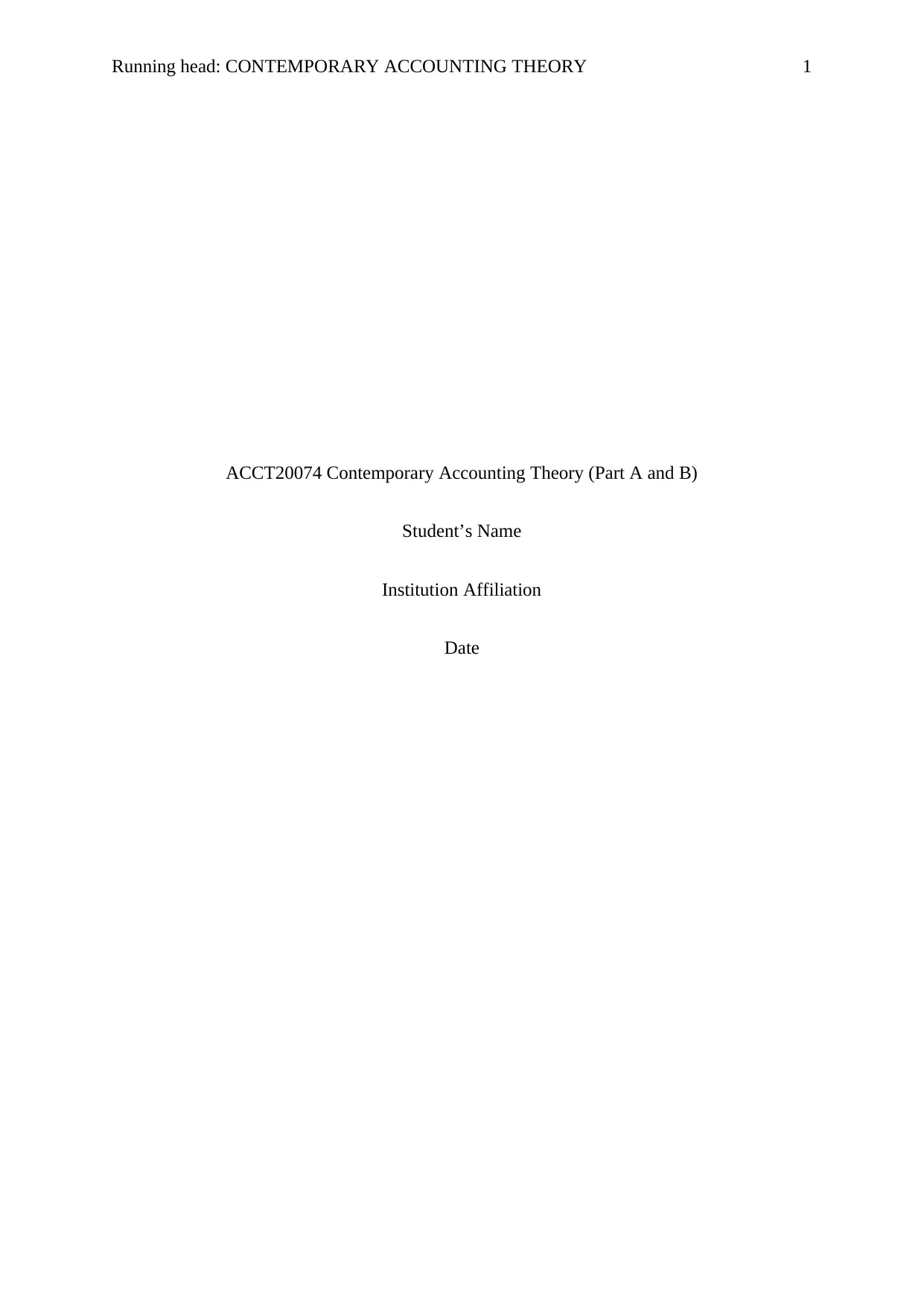
Running head: CONTEMPORARY ACCOUNTING THEORY 1
ACCT20074 Contemporary Accounting Theory (Part A and B)
Student’s Name
Institution Affiliation
Date
ACCT20074 Contemporary Accounting Theory (Part A and B)
Student’s Name
Institution Affiliation
Date
Paraphrase This Document
Need a fresh take? Get an instant paraphrase of this document with our AI Paraphraser
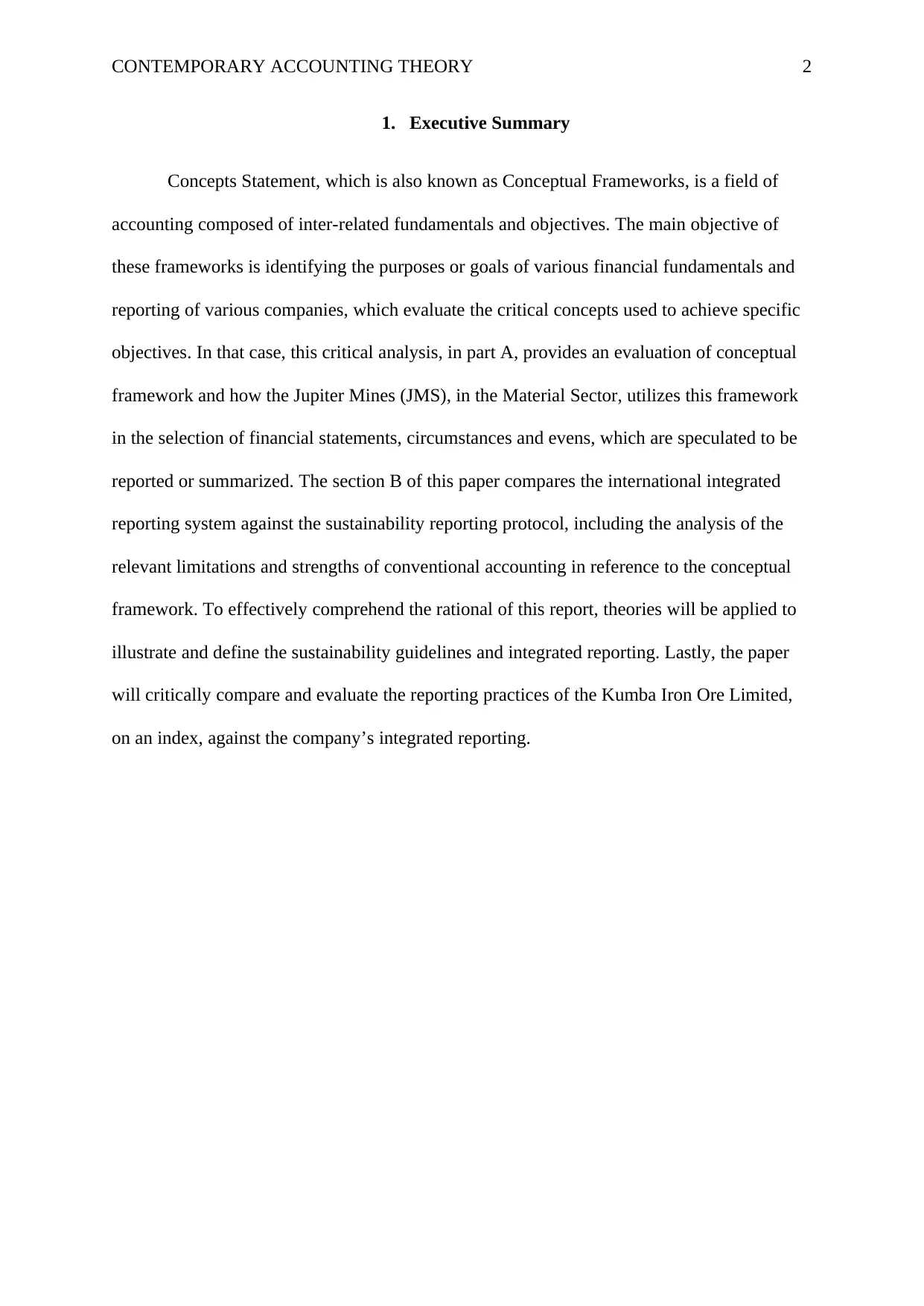
CONTEMPORARY ACCOUNTING THEORY 2
1. Executive Summary
Concepts Statement, which is also known as Conceptual Frameworks, is a field of
accounting composed of inter-related fundamentals and objectives. The main objective of
these frameworks is identifying the purposes or goals of various financial fundamentals and
reporting of various companies, which evaluate the critical concepts used to achieve specific
objectives. In that case, this critical analysis, in part A, provides an evaluation of conceptual
framework and how the Jupiter Mines (JMS), in the Material Sector, utilizes this framework
in the selection of financial statements, circumstances and evens, which are speculated to be
reported or summarized. The section B of this paper compares the international integrated
reporting system against the sustainability reporting protocol, including the analysis of the
relevant limitations and strengths of conventional accounting in reference to the conceptual
framework. To effectively comprehend the rational of this report, theories will be applied to
illustrate and define the sustainability guidelines and integrated reporting. Lastly, the paper
will critically compare and evaluate the reporting practices of the Kumba Iron Ore Limited,
on an index, against the company’s integrated reporting.
1. Executive Summary
Concepts Statement, which is also known as Conceptual Frameworks, is a field of
accounting composed of inter-related fundamentals and objectives. The main objective of
these frameworks is identifying the purposes or goals of various financial fundamentals and
reporting of various companies, which evaluate the critical concepts used to achieve specific
objectives. In that case, this critical analysis, in part A, provides an evaluation of conceptual
framework and how the Jupiter Mines (JMS), in the Material Sector, utilizes this framework
in the selection of financial statements, circumstances and evens, which are speculated to be
reported or summarized. The section B of this paper compares the international integrated
reporting system against the sustainability reporting protocol, including the analysis of the
relevant limitations and strengths of conventional accounting in reference to the conceptual
framework. To effectively comprehend the rational of this report, theories will be applied to
illustrate and define the sustainability guidelines and integrated reporting. Lastly, the paper
will critically compare and evaluate the reporting practices of the Kumba Iron Ore Limited,
on an index, against the company’s integrated reporting.

CONTEMPORARY ACCOUNTING THEORY 3
2. Introduction
The framework documentation is mandated to present the fundamental concepts,
which underlie and govern the presentation and preparation of a company’s financial
statements. These statements are utilized by external users to formulate a Conceptual
Framework (CF) fundamental for financial evaluation. Thus, it relevant to comprehend the
documentation serves a critical aim of assisting the IASB to formulate revised financial
standards, which is relevant for financial statements applicable by companies when applying
financial protocols or handling problems evident in the compliance activities to specific
accounting standards. In that regard, this paper analyses the conceptual framework purposed
for financial reporting and its relevance and application in an Australian Company i.e. The
Jupiter Mines (JMS). The second paper of this paper will evaluate the sustainability and
integrated reporting frameworks applicable in a South African Company i.e. The Kumba Iron
Ore Limited.
3. Part A
a) Review of the history and development of the Conceptual Framework for
Financial Reporting
The development of the Conceptual Framework in the US, UK and globally started in
1976 and introduced by the FASB in the United States. This framework was formulated as a
basic for outlaying the relevant financial rules and mitigating the present accounting reporting
issues. From 1978 to 2010, the governing entity has issues 8 accounting statements regarding
the relevant financial reporting applied by various companies, including one SFAC No. 4,
which is a reporting that applies to non-business enterprises. However, SFACs No. 1, 2 and 3
have already been replaced, which leave only 5 as valid SFAC Nos. The reporting is the
SFAC No. 4, which represent the belated frameworks considered by the International
2. Introduction
The framework documentation is mandated to present the fundamental concepts,
which underlie and govern the presentation and preparation of a company’s financial
statements. These statements are utilized by external users to formulate a Conceptual
Framework (CF) fundamental for financial evaluation. Thus, it relevant to comprehend the
documentation serves a critical aim of assisting the IASB to formulate revised financial
standards, which is relevant for financial statements applicable by companies when applying
financial protocols or handling problems evident in the compliance activities to specific
accounting standards. In that regard, this paper analyses the conceptual framework purposed
for financial reporting and its relevance and application in an Australian Company i.e. The
Jupiter Mines (JMS). The second paper of this paper will evaluate the sustainability and
integrated reporting frameworks applicable in a South African Company i.e. The Kumba Iron
Ore Limited.
3. Part A
a) Review of the history and development of the Conceptual Framework for
Financial Reporting
The development of the Conceptual Framework in the US, UK and globally started in
1976 and introduced by the FASB in the United States. This framework was formulated as a
basic for outlaying the relevant financial rules and mitigating the present accounting reporting
issues. From 1978 to 2010, the governing entity has issues 8 accounting statements regarding
the relevant financial reporting applied by various companies, including one SFAC No. 4,
which is a reporting that applies to non-business enterprises. However, SFACs No. 1, 2 and 3
have already been replaced, which leave only 5 as valid SFAC Nos. The reporting is the
SFAC No. 4, which represent the belated frameworks considered by the International
⊘ This is a preview!⊘
Do you want full access?
Subscribe today to unlock all pages.

Trusted by 1+ million students worldwide

CONTEMPORARY ACCOUNTING THEORY 4
Accounting Standards Committee (IASC). This accounting body was established in 1973,
which represented a predecessor entity of the accounting standards body globally. By 1st
April 2010, the accounting entity (IASB) assumed the role of IASC obliged to set out the
global accounting frameworks, despite the current standards being reference to as the
International Financial Reporting Standards (IFRS) (Timbate & Park, 2018). In 1975, the
entity presented its initial reporting of the IAS, which represented the accounting policy
disclosure (Crombie, 2012). The IASC presented its 28th IAS by April 1989, which
represented the financial statements for investment in the relevant associates. In that case, the
conceptual framework developed for the presentation and preparation of accounting
frameworks had been approved by April 1989 by the IASC.
This CF, in United Kingdom, was therefore published in 1989 and applied by the
IASB in 2001, despite its relevance in formulating and unindustrialized the IAS framework.
For the purpose of delayed issuance of the standard, the fundamental purpose of the CF is to
assist the financial entity to formulate International Accounting Standards in the future; and
allow the review of the present Standards paragraphs (IASB, 2010b and B1713) signifying
this framework. The accounting body committed itself into an agreement with the United
States’ FASB, which was referred as the 2nd Norwalk Agreement by 2002; and mandating
that two accounting entities would principally consider removing its present differences and
merge on the basis of the quality conceptual framework (Ehoff, 2010).
As for Australia, the CF was formulated by the AASB and AARF dated from 1985 to
1995. The accounting concepts considering the financial statement had been delivered before
2002, the moment when FRC decide to implement the International Accounting Standard in
Australia (Ehoff, 2010). The accounting statements included SAC 1, 2, 3 and 4.
Accounting Standards Committee (IASC). This accounting body was established in 1973,
which represented a predecessor entity of the accounting standards body globally. By 1st
April 2010, the accounting entity (IASB) assumed the role of IASC obliged to set out the
global accounting frameworks, despite the current standards being reference to as the
International Financial Reporting Standards (IFRS) (Timbate & Park, 2018). In 1975, the
entity presented its initial reporting of the IAS, which represented the accounting policy
disclosure (Crombie, 2012). The IASC presented its 28th IAS by April 1989, which
represented the financial statements for investment in the relevant associates. In that case, the
conceptual framework developed for the presentation and preparation of accounting
frameworks had been approved by April 1989 by the IASC.
This CF, in United Kingdom, was therefore published in 1989 and applied by the
IASB in 2001, despite its relevance in formulating and unindustrialized the IAS framework.
For the purpose of delayed issuance of the standard, the fundamental purpose of the CF is to
assist the financial entity to formulate International Accounting Standards in the future; and
allow the review of the present Standards paragraphs (IASB, 2010b and B1713) signifying
this framework. The accounting body committed itself into an agreement with the United
States’ FASB, which was referred as the 2nd Norwalk Agreement by 2002; and mandating
that two accounting entities would principally consider removing its present differences and
merge on the basis of the quality conceptual framework (Ehoff, 2010).
As for Australia, the CF was formulated by the AASB and AARF dated from 1985 to
1995. The accounting concepts considering the financial statement had been delivered before
2002, the moment when FRC decide to implement the International Accounting Standard in
Australia (Ehoff, 2010). The accounting statements included SAC 1, 2, 3 and 4.
Paraphrase This Document
Need a fresh take? Get an instant paraphrase of this document with our AI Paraphraser
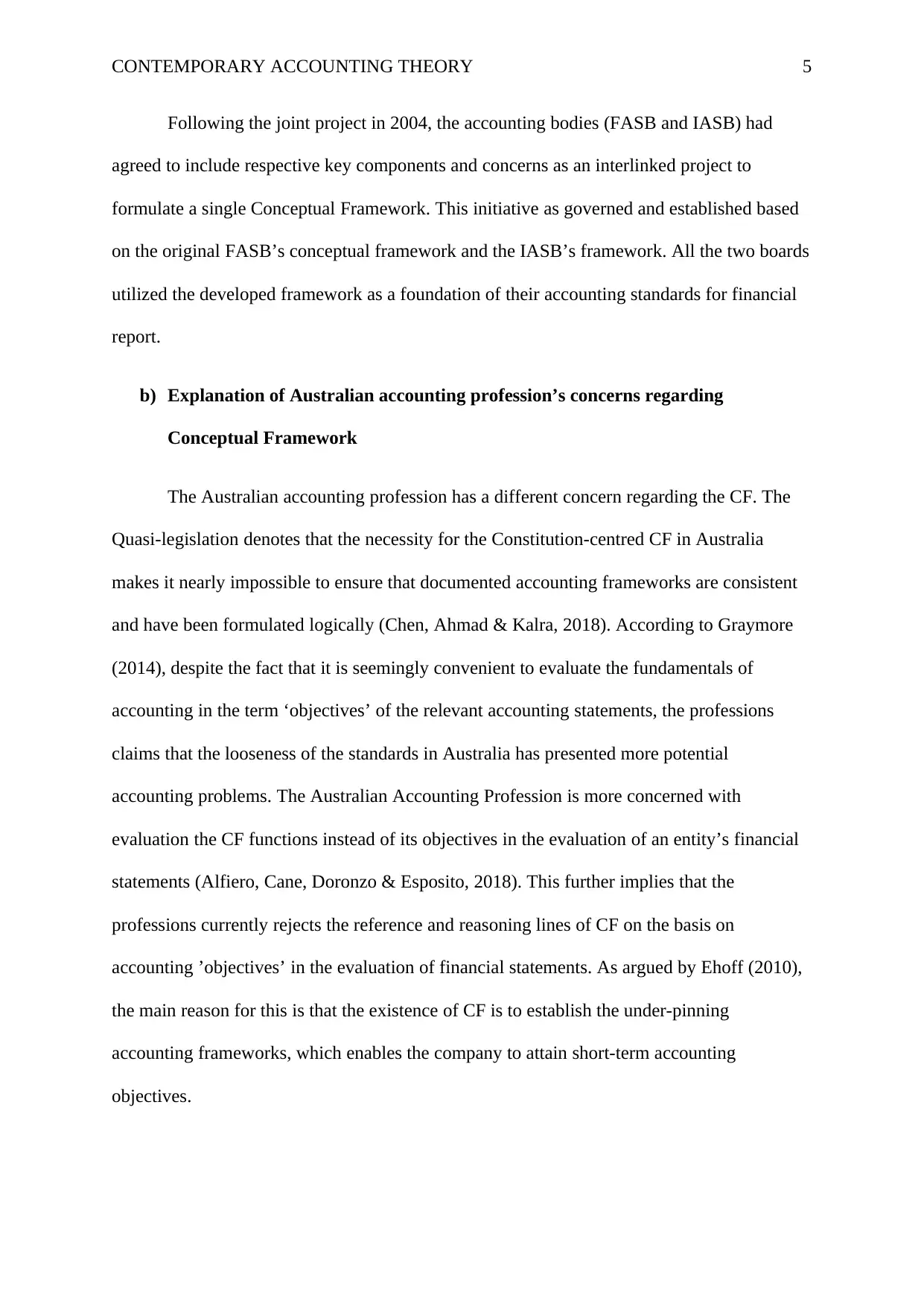
CONTEMPORARY ACCOUNTING THEORY 5
Following the joint project in 2004, the accounting bodies (FASB and IASB) had
agreed to include respective key components and concerns as an interlinked project to
formulate a single Conceptual Framework. This initiative as governed and established based
on the original FASB’s conceptual framework and the IASB’s framework. All the two boards
utilized the developed framework as a foundation of their accounting standards for financial
report.
b) Explanation of Australian accounting profession’s concerns regarding
Conceptual Framework
The Australian accounting profession has a different concern regarding the CF. The
Quasi-legislation denotes that the necessity for the Constitution-centred CF in Australia
makes it nearly impossible to ensure that documented accounting frameworks are consistent
and have been formulated logically (Chen, Ahmad & Kalra, 2018). According to Graymore
(2014), despite the fact that it is seemingly convenient to evaluate the fundamentals of
accounting in the term ‘objectives’ of the relevant accounting statements, the professions
claims that the looseness of the standards in Australia has presented more potential
accounting problems. The Australian Accounting Profession is more concerned with
evaluation the CF functions instead of its objectives in the evaluation of an entity’s financial
statements (Alfiero, Cane, Doronzo & Esposito, 2018). This further implies that the
professions currently rejects the reference and reasoning lines of CF on the basis on
accounting ’objectives’ in the evaluation of financial statements. As argued by Ehoff (2010),
the main reason for this is that the existence of CF is to establish the under-pinning
accounting frameworks, which enables the company to attain short-term accounting
objectives.
Following the joint project in 2004, the accounting bodies (FASB and IASB) had
agreed to include respective key components and concerns as an interlinked project to
formulate a single Conceptual Framework. This initiative as governed and established based
on the original FASB’s conceptual framework and the IASB’s framework. All the two boards
utilized the developed framework as a foundation of their accounting standards for financial
report.
b) Explanation of Australian accounting profession’s concerns regarding
Conceptual Framework
The Australian accounting profession has a different concern regarding the CF. The
Quasi-legislation denotes that the necessity for the Constitution-centred CF in Australia
makes it nearly impossible to ensure that documented accounting frameworks are consistent
and have been formulated logically (Chen, Ahmad & Kalra, 2018). According to Graymore
(2014), despite the fact that it is seemingly convenient to evaluate the fundamentals of
accounting in the term ‘objectives’ of the relevant accounting statements, the professions
claims that the looseness of the standards in Australia has presented more potential
accounting problems. The Australian Accounting Profession is more concerned with
evaluation the CF functions instead of its objectives in the evaluation of an entity’s financial
statements (Alfiero, Cane, Doronzo & Esposito, 2018). This further implies that the
professions currently rejects the reference and reasoning lines of CF on the basis on
accounting ’objectives’ in the evaluation of financial statements. As argued by Ehoff (2010),
the main reason for this is that the existence of CF is to establish the under-pinning
accounting frameworks, which enables the company to attain short-term accounting
objectives.
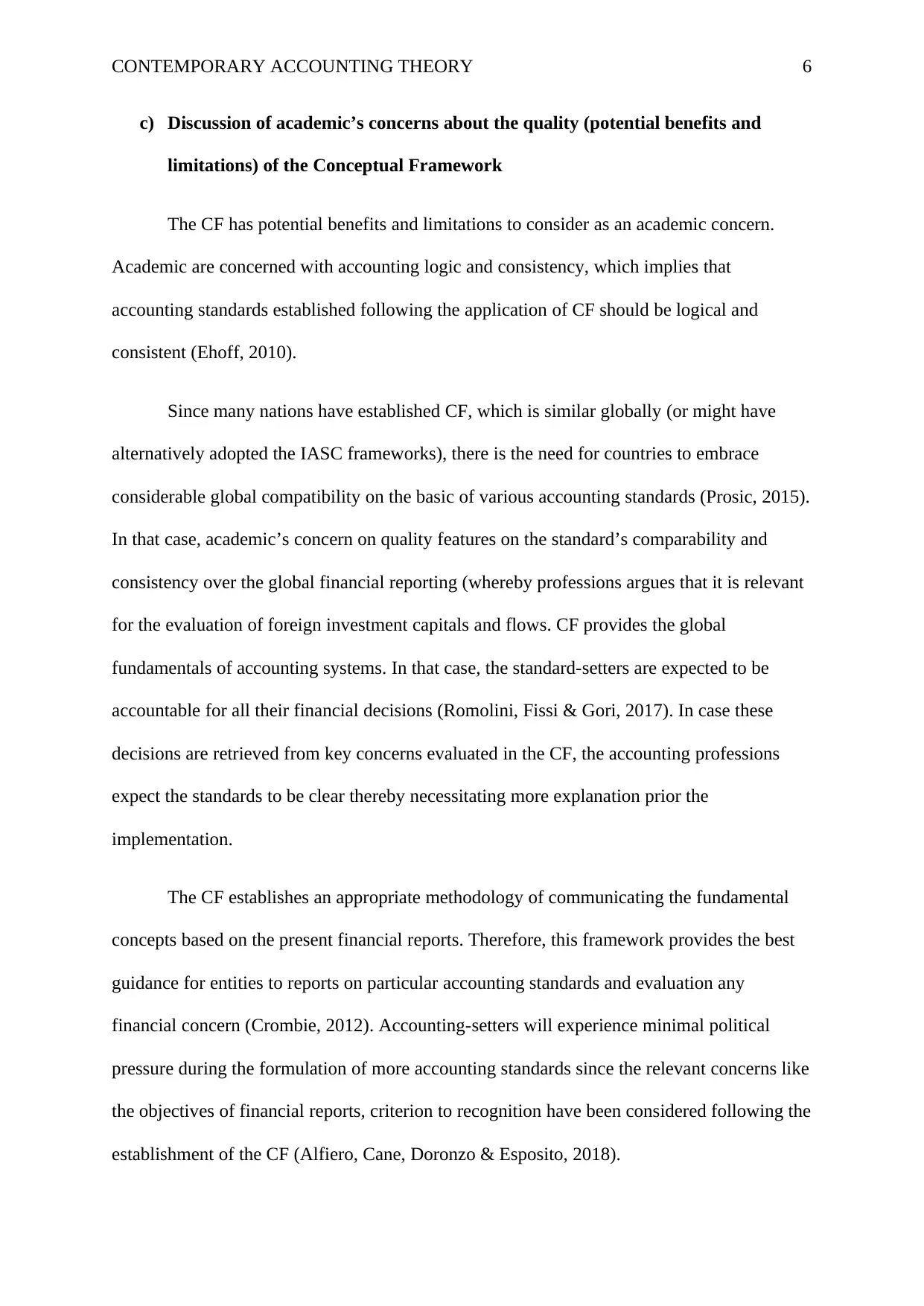
CONTEMPORARY ACCOUNTING THEORY 6
c) Discussion of academic’s concerns about the quality (potential benefits and
limitations) of the Conceptual Framework
The CF has potential benefits and limitations to consider as an academic concern.
Academic are concerned with accounting logic and consistency, which implies that
accounting standards established following the application of CF should be logical and
consistent (Ehoff, 2010).
Since many nations have established CF, which is similar globally (or might have
alternatively adopted the IASC frameworks), there is the need for countries to embrace
considerable global compatibility on the basic of various accounting standards (Prosic, 2015).
In that case, academic’s concern on quality features on the standard’s comparability and
consistency over the global financial reporting (whereby professions argues that it is relevant
for the evaluation of foreign investment capitals and flows. CF provides the global
fundamentals of accounting systems. In that case, the standard-setters are expected to be
accountable for all their financial decisions (Romolini, Fissi & Gori, 2017). In case these
decisions are retrieved from key concerns evaluated in the CF, the accounting professions
expect the standards to be clear thereby necessitating more explanation prior the
implementation.
The CF establishes an appropriate methodology of communicating the fundamental
concepts based on the present financial reports. Therefore, this framework provides the best
guidance for entities to reports on particular accounting standards and evaluation any
financial concern (Crombie, 2012). Accounting-setters will experience minimal political
pressure during the formulation of more accounting standards since the relevant concerns like
the objectives of financial reports, criterion to recognition have been considered following the
establishment of the CF (Alfiero, Cane, Doronzo & Esposito, 2018).
c) Discussion of academic’s concerns about the quality (potential benefits and
limitations) of the Conceptual Framework
The CF has potential benefits and limitations to consider as an academic concern.
Academic are concerned with accounting logic and consistency, which implies that
accounting standards established following the application of CF should be logical and
consistent (Ehoff, 2010).
Since many nations have established CF, which is similar globally (or might have
alternatively adopted the IASC frameworks), there is the need for countries to embrace
considerable global compatibility on the basic of various accounting standards (Prosic, 2015).
In that case, academic’s concern on quality features on the standard’s comparability and
consistency over the global financial reporting (whereby professions argues that it is relevant
for the evaluation of foreign investment capitals and flows. CF provides the global
fundamentals of accounting systems. In that case, the standard-setters are expected to be
accountable for all their financial decisions (Romolini, Fissi & Gori, 2017). In case these
decisions are retrieved from key concerns evaluated in the CF, the accounting professions
expect the standards to be clear thereby necessitating more explanation prior the
implementation.
The CF establishes an appropriate methodology of communicating the fundamental
concepts based on the present financial reports. Therefore, this framework provides the best
guidance for entities to reports on particular accounting standards and evaluation any
financial concern (Crombie, 2012). Accounting-setters will experience minimal political
pressure during the formulation of more accounting standards since the relevant concerns like
the objectives of financial reports, criterion to recognition have been considered following the
establishment of the CF (Alfiero, Cane, Doronzo & Esposito, 2018).
⊘ This is a preview!⊘
Do you want full access?
Subscribe today to unlock all pages.

Trusted by 1+ million students worldwide

CONTEMPORARY ACCOUNTING THEORY 7
A portion of the limitations that have been related to conceptual frameworks of
bookkeeping include: Conceptual frameworks are outrageous to formulate; the enhancement
of the CF is affected by the governmental actions (Ehoff, 2010). With this, some accountants
present the concern that CFs is more inclined to political procedures; Linked to the limitation
outlined above, whenever the CF considers involving accounting concerns, there is always an
issue of financial estimation of given assets as argued by (Molyneux & Wilson, 2017). The
CFs considers more on financial-related matters. In that case, this framework will consider
disregarding various execution segments such as ecological and social revealing components
(Alfiero, Cane, Doronzo & Esposito, 2018).. Moreover, through the evaluation of financial
execution, CFs critically transits the consideration of financial analysts based on corporate
execution.
d) Explanation of how the conceptual framework has been applied by the selected
Australian Company
(i) How many statements/reports have been prepared as per the Conceptual Framework
and what are their major components
Fig. 1: Consolidate Financial Statement Position of JMS (28th Feb 2018)
A portion of the limitations that have been related to conceptual frameworks of
bookkeeping include: Conceptual frameworks are outrageous to formulate; the enhancement
of the CF is affected by the governmental actions (Ehoff, 2010). With this, some accountants
present the concern that CFs is more inclined to political procedures; Linked to the limitation
outlined above, whenever the CF considers involving accounting concerns, there is always an
issue of financial estimation of given assets as argued by (Molyneux & Wilson, 2017). The
CFs considers more on financial-related matters. In that case, this framework will consider
disregarding various execution segments such as ecological and social revealing components
(Alfiero, Cane, Doronzo & Esposito, 2018).. Moreover, through the evaluation of financial
execution, CFs critically transits the consideration of financial analysts based on corporate
execution.
d) Explanation of how the conceptual framework has been applied by the selected
Australian Company
(i) How many statements/reports have been prepared as per the Conceptual Framework
and what are their major components
Fig. 1: Consolidate Financial Statement Position of JMS (28th Feb 2018)
Paraphrase This Document
Need a fresh take? Get an instant paraphrase of this document with our AI Paraphraser
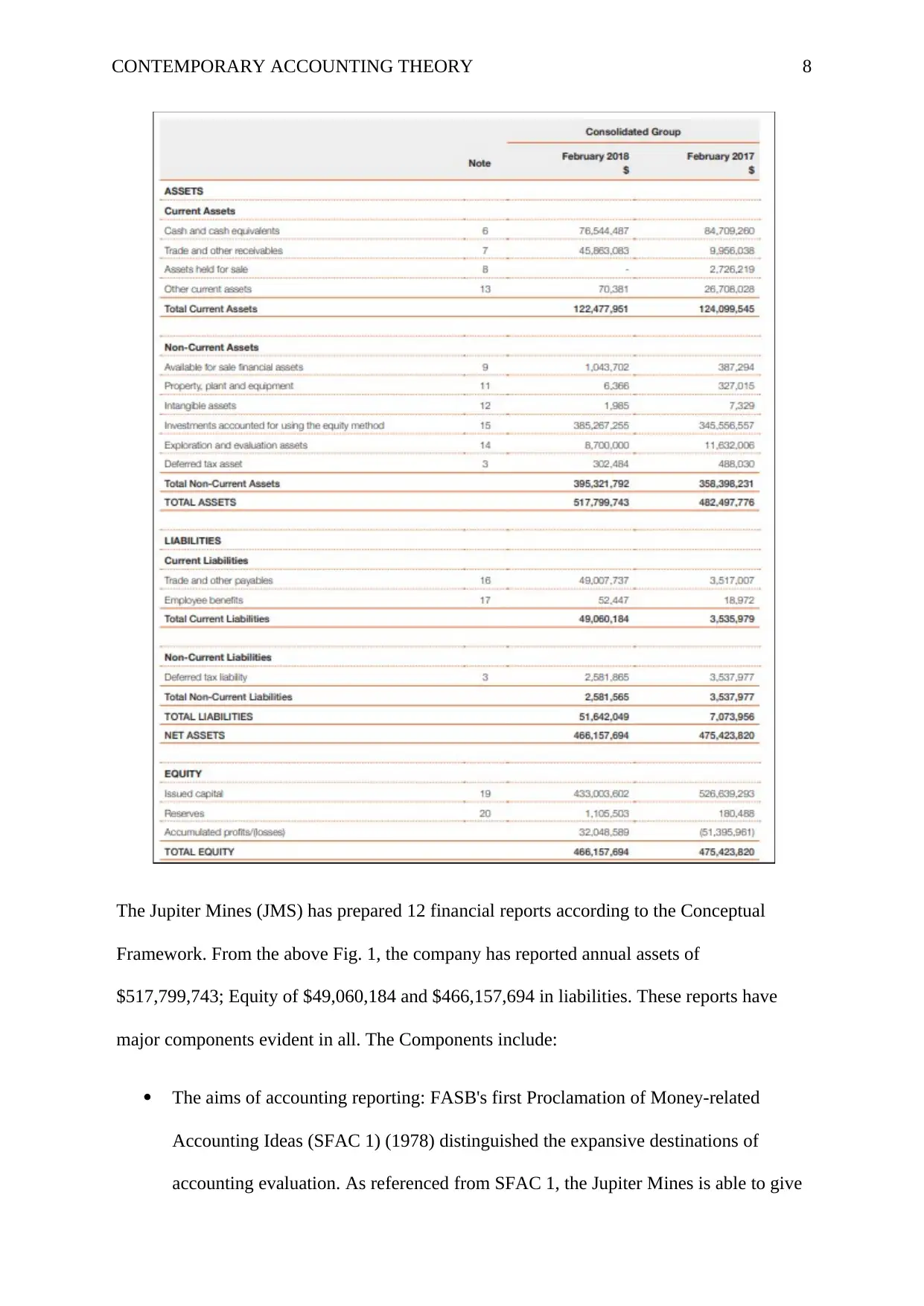
CONTEMPORARY ACCOUNTING THEORY 8
The Jupiter Mines (JMS) has prepared 12 financial reports according to the Conceptual
Framework. From the above Fig. 1, the company has reported annual assets of
$517,799,743; Equity of $49,060,184 and $466,157,694 in liabilities. These reports have
major components evident in all. The Components include:
The aims of accounting reporting: FASB's first Proclamation of Money-related
Accounting Ideas (SFAC 1) (1978) distinguished the expansive destinations of
accounting evaluation. As referenced from SFAC 1, the Jupiter Mines is able to give
The Jupiter Mines (JMS) has prepared 12 financial reports according to the Conceptual
Framework. From the above Fig. 1, the company has reported annual assets of
$517,799,743; Equity of $49,060,184 and $466,157,694 in liabilities. These reports have
major components evident in all. The Components include:
The aims of accounting reporting: FASB's first Proclamation of Money-related
Accounting Ideas (SFAC 1) (1978) distinguished the expansive destinations of
accounting evaluation. As referenced from SFAC 1, the Jupiter Mines is able to give
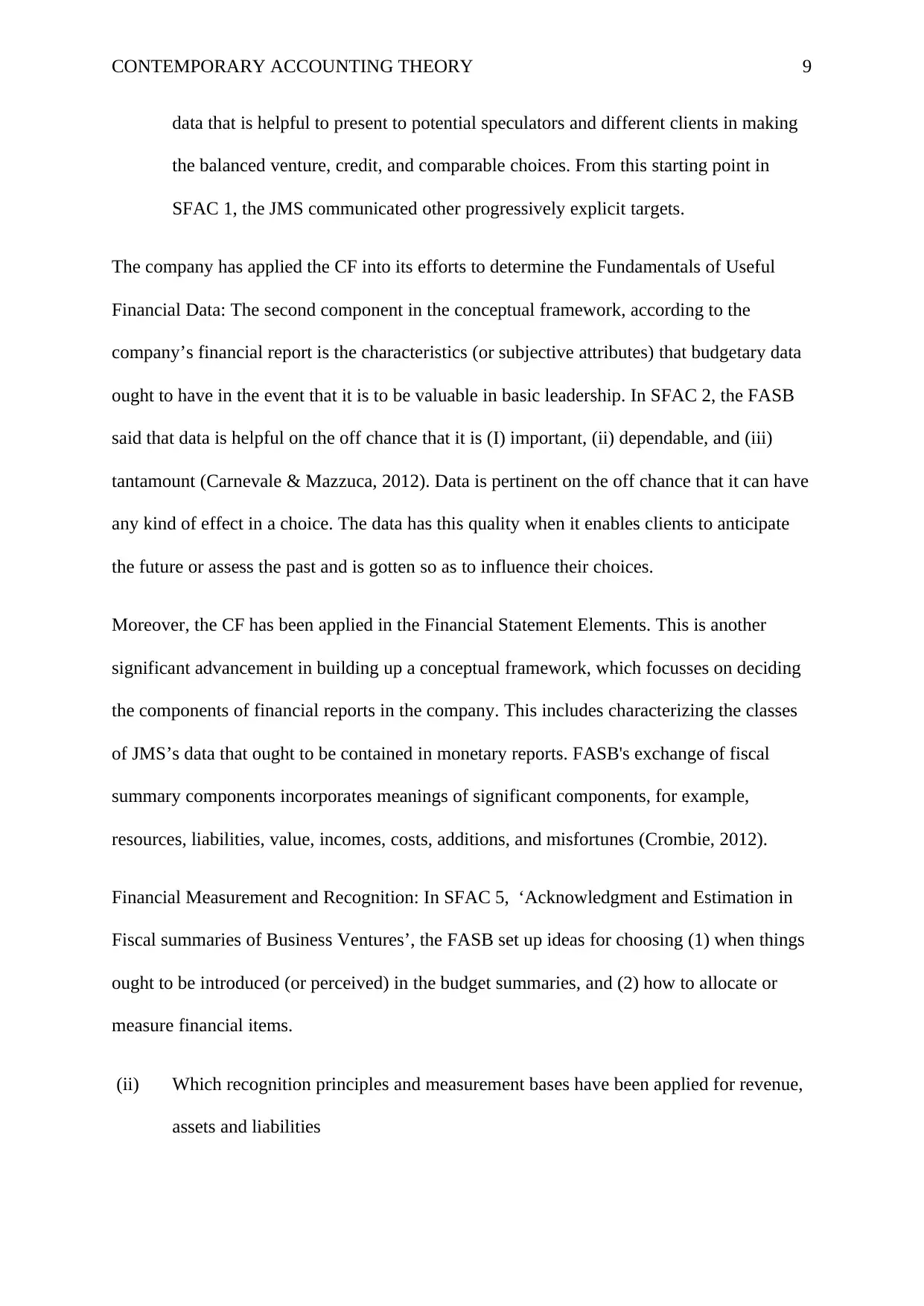
CONTEMPORARY ACCOUNTING THEORY 9
data that is helpful to present to potential speculators and different clients in making
the balanced venture, credit, and comparable choices. From this starting point in
SFAC 1, the JMS communicated other progressively explicit targets.
The company has applied the CF into its efforts to determine the Fundamentals of Useful
Financial Data: The second component in the conceptual framework, according to the
company’s financial report is the characteristics (or subjective attributes) that budgetary data
ought to have in the event that it is to be valuable in basic leadership. In SFAC 2, the FASB
said that data is helpful on the off chance that it is (I) important, (ii) dependable, and (iii)
tantamount (Carnevale & Mazzuca, 2012). Data is pertinent on the off chance that it can have
any kind of effect in a choice. The data has this quality when it enables clients to anticipate
the future or assess the past and is gotten so as to influence their choices.
Moreover, the CF has been applied in the Financial Statement Elements. This is another
significant advancement in building up a conceptual framework, which focusses on deciding
the components of financial reports in the company. This includes characterizing the classes
of JMS’s data that ought to be contained in monetary reports. FASB's exchange of fiscal
summary components incorporates meanings of significant components, for example,
resources, liabilities, value, incomes, costs, additions, and misfortunes (Crombie, 2012).
Financial Measurement and Recognition: In SFAC 5, ‘Acknowledgment and Estimation in
Fiscal summaries of Business Ventures’, the FASB set up ideas for choosing (1) when things
ought to be introduced (or perceived) in the budget summaries, and (2) how to allocate or
measure financial items.
(ii) Which recognition principles and measurement bases have been applied for revenue,
assets and liabilities
data that is helpful to present to potential speculators and different clients in making
the balanced venture, credit, and comparable choices. From this starting point in
SFAC 1, the JMS communicated other progressively explicit targets.
The company has applied the CF into its efforts to determine the Fundamentals of Useful
Financial Data: The second component in the conceptual framework, according to the
company’s financial report is the characteristics (or subjective attributes) that budgetary data
ought to have in the event that it is to be valuable in basic leadership. In SFAC 2, the FASB
said that data is helpful on the off chance that it is (I) important, (ii) dependable, and (iii)
tantamount (Carnevale & Mazzuca, 2012). Data is pertinent on the off chance that it can have
any kind of effect in a choice. The data has this quality when it enables clients to anticipate
the future or assess the past and is gotten so as to influence their choices.
Moreover, the CF has been applied in the Financial Statement Elements. This is another
significant advancement in building up a conceptual framework, which focusses on deciding
the components of financial reports in the company. This includes characterizing the classes
of JMS’s data that ought to be contained in monetary reports. FASB's exchange of fiscal
summary components incorporates meanings of significant components, for example,
resources, liabilities, value, incomes, costs, additions, and misfortunes (Crombie, 2012).
Financial Measurement and Recognition: In SFAC 5, ‘Acknowledgment and Estimation in
Fiscal summaries of Business Ventures’, the FASB set up ideas for choosing (1) when things
ought to be introduced (or perceived) in the budget summaries, and (2) how to allocate or
measure financial items.
(ii) Which recognition principles and measurement bases have been applied for revenue,
assets and liabilities
⊘ This is a preview!⊘
Do you want full access?
Subscribe today to unlock all pages.

Trusted by 1+ million students worldwide
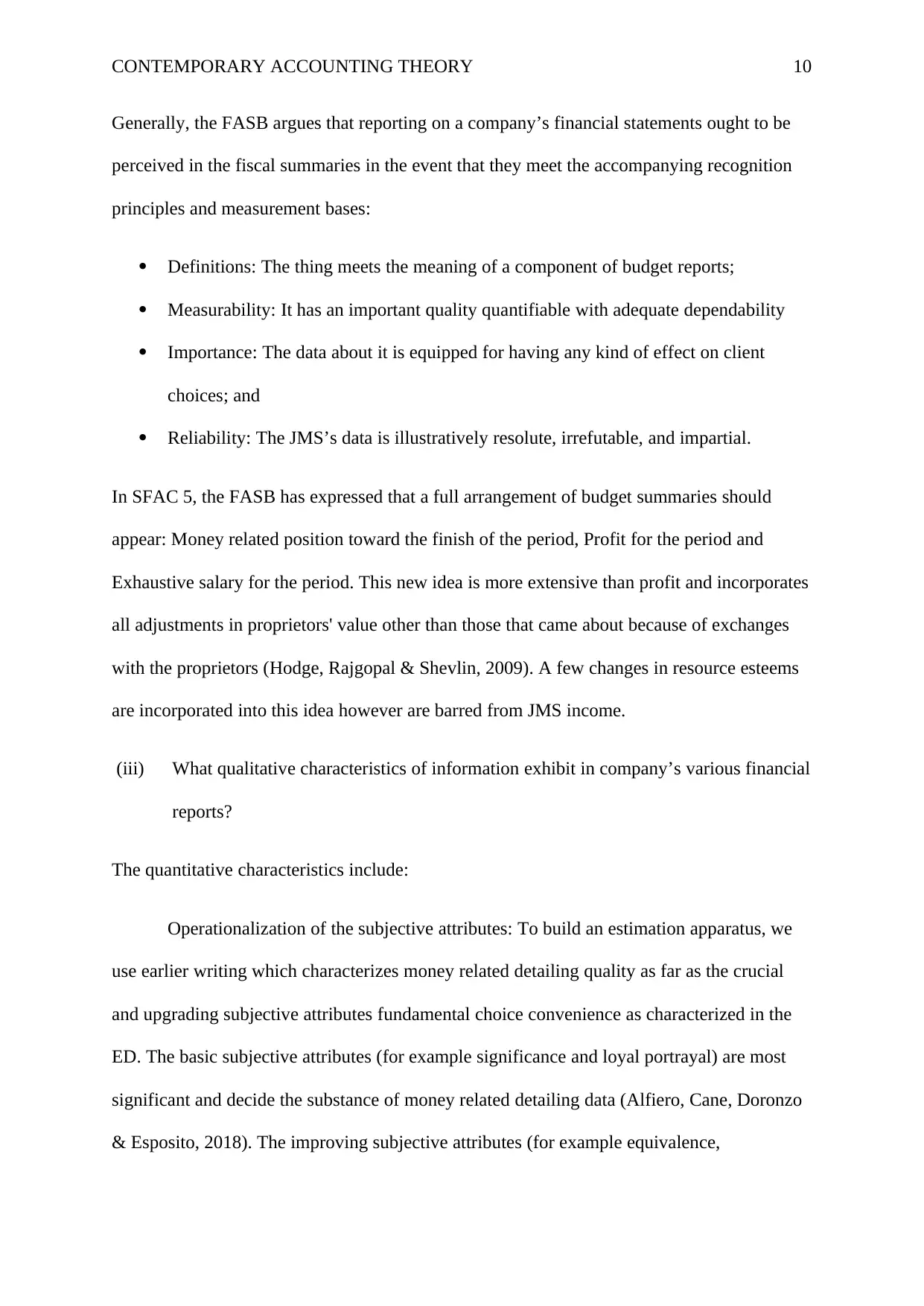
CONTEMPORARY ACCOUNTING THEORY 10
Generally, the FASB argues that reporting on a company’s financial statements ought to be
perceived in the fiscal summaries in the event that they meet the accompanying recognition
principles and measurement bases:
Definitions: The thing meets the meaning of a component of budget reports;
Measurability: It has an important quality quantifiable with adequate dependability
Importance: The data about it is equipped for having any kind of effect on client
choices; and
Reliability: The JMS’s data is illustratively resolute, irrefutable, and impartial.
In SFAC 5, the FASB has expressed that a full arrangement of budget summaries should
appear: Money related position toward the finish of the period, Profit for the period and
Exhaustive salary for the period. This new idea is more extensive than profit and incorporates
all adjustments in proprietors' value other than those that came about because of exchanges
with the proprietors (Hodge, Rajgopal & Shevlin, 2009). A few changes in resource esteems
are incorporated into this idea however are barred from JMS income.
(iii) What qualitative characteristics of information exhibit in company’s various financial
reports?
The quantitative characteristics include:
Operationalization of the subjective attributes: To build an estimation apparatus, we
use earlier writing which characterizes money related detailing quality as far as the crucial
and upgrading subjective attributes fundamental choice convenience as characterized in the
ED. The basic subjective attributes (for example significance and loyal portrayal) are most
significant and decide the substance of money related detailing data (Alfiero, Cane, Doronzo
& Esposito, 2018). The improving subjective attributes (for example equivalence,
Generally, the FASB argues that reporting on a company’s financial statements ought to be
perceived in the fiscal summaries in the event that they meet the accompanying recognition
principles and measurement bases:
Definitions: The thing meets the meaning of a component of budget reports;
Measurability: It has an important quality quantifiable with adequate dependability
Importance: The data about it is equipped for having any kind of effect on client
choices; and
Reliability: The JMS’s data is illustratively resolute, irrefutable, and impartial.
In SFAC 5, the FASB has expressed that a full arrangement of budget summaries should
appear: Money related position toward the finish of the period, Profit for the period and
Exhaustive salary for the period. This new idea is more extensive than profit and incorporates
all adjustments in proprietors' value other than those that came about because of exchanges
with the proprietors (Hodge, Rajgopal & Shevlin, 2009). A few changes in resource esteems
are incorporated into this idea however are barred from JMS income.
(iii) What qualitative characteristics of information exhibit in company’s various financial
reports?
The quantitative characteristics include:
Operationalization of the subjective attributes: To build an estimation apparatus, we
use earlier writing which characterizes money related detailing quality as far as the crucial
and upgrading subjective attributes fundamental choice convenience as characterized in the
ED. The basic subjective attributes (for example significance and loyal portrayal) are most
significant and decide the substance of money related detailing data (Alfiero, Cane, Doronzo
& Esposito, 2018). The improving subjective attributes (for example equivalence,
Paraphrase This Document
Need a fresh take? Get an instant paraphrase of this document with our AI Paraphraser
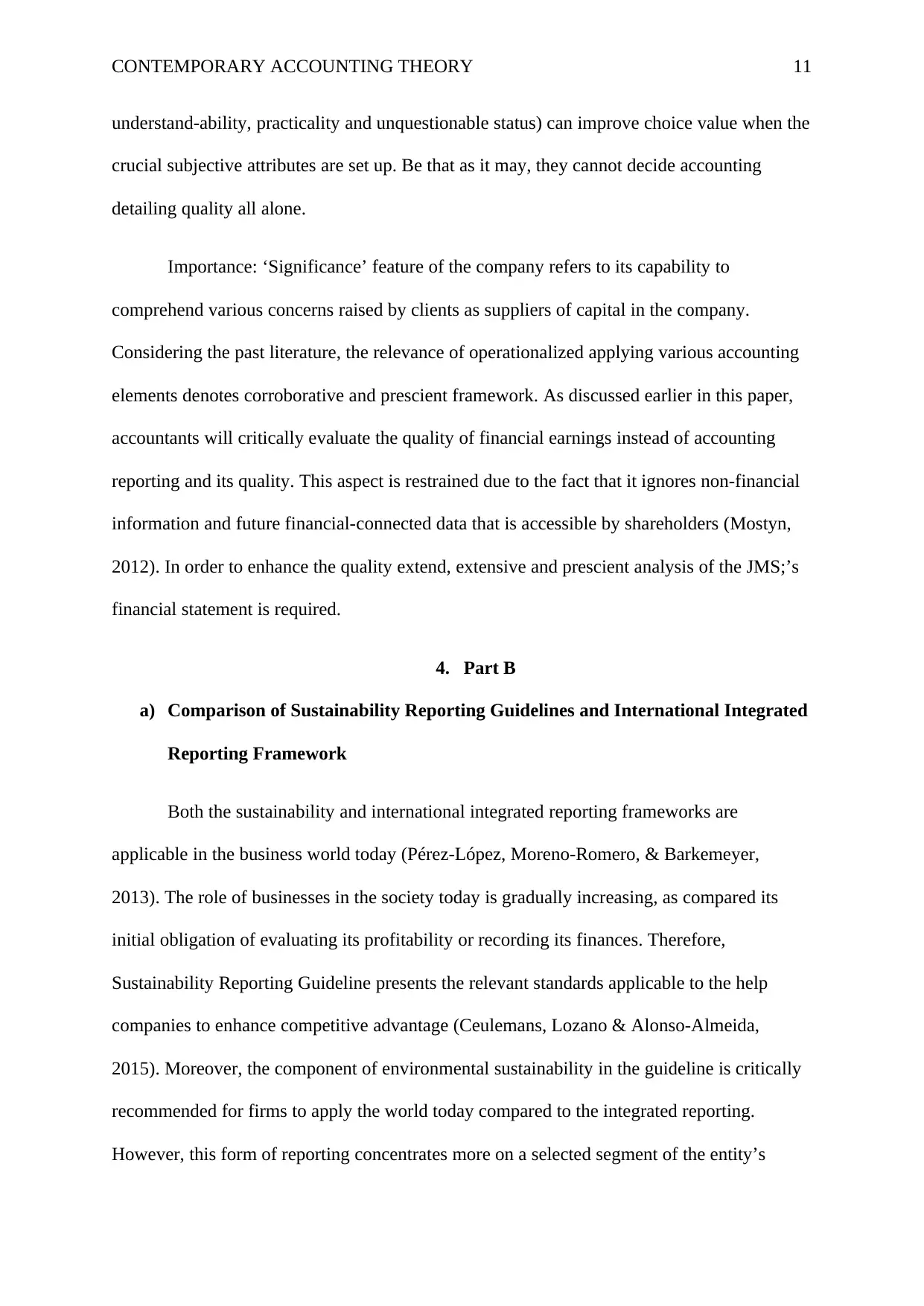
CONTEMPORARY ACCOUNTING THEORY 11
understand-ability, practicality and unquestionable status) can improve choice value when the
crucial subjective attributes are set up. Be that as it may, they cannot decide accounting
detailing quality all alone.
Importance: ‘Significance’ feature of the company refers to its capability to
comprehend various concerns raised by clients as suppliers of capital in the company.
Considering the past literature, the relevance of operationalized applying various accounting
elements denotes corroborative and prescient framework. As discussed earlier in this paper,
accountants will critically evaluate the quality of financial earnings instead of accounting
reporting and its quality. This aspect is restrained due to the fact that it ignores non-financial
information and future financial-connected data that is accessible by shareholders (Mostyn,
2012). In order to enhance the quality extend, extensive and prescient analysis of the JMS;’s
financial statement is required.
4. Part B
a) Comparison of Sustainability Reporting Guidelines and International Integrated
Reporting Framework
Both the sustainability and international integrated reporting frameworks are
applicable in the business world today (Pérez-López, Moreno-Romero, & Barkemeyer,
2013). The role of businesses in the society today is gradually increasing, as compared its
initial obligation of evaluating its profitability or recording its finances. Therefore,
Sustainability Reporting Guideline presents the relevant standards applicable to the help
companies to enhance competitive advantage (Ceulemans, Lozano & Alonso-Almeida,
2015). Moreover, the component of environmental sustainability in the guideline is critically
recommended for firms to apply the world today compared to the integrated reporting.
However, this form of reporting concentrates more on a selected segment of the entity’s
understand-ability, practicality and unquestionable status) can improve choice value when the
crucial subjective attributes are set up. Be that as it may, they cannot decide accounting
detailing quality all alone.
Importance: ‘Significance’ feature of the company refers to its capability to
comprehend various concerns raised by clients as suppliers of capital in the company.
Considering the past literature, the relevance of operationalized applying various accounting
elements denotes corroborative and prescient framework. As discussed earlier in this paper,
accountants will critically evaluate the quality of financial earnings instead of accounting
reporting and its quality. This aspect is restrained due to the fact that it ignores non-financial
information and future financial-connected data that is accessible by shareholders (Mostyn,
2012). In order to enhance the quality extend, extensive and prescient analysis of the JMS;’s
financial statement is required.
4. Part B
a) Comparison of Sustainability Reporting Guidelines and International Integrated
Reporting Framework
Both the sustainability and international integrated reporting frameworks are
applicable in the business world today (Pérez-López, Moreno-Romero, & Barkemeyer,
2013). The role of businesses in the society today is gradually increasing, as compared its
initial obligation of evaluating its profitability or recording its finances. Therefore,
Sustainability Reporting Guideline presents the relevant standards applicable to the help
companies to enhance competitive advantage (Ceulemans, Lozano & Alonso-Almeida,
2015). Moreover, the component of environmental sustainability in the guideline is critically
recommended for firms to apply the world today compared to the integrated reporting.
However, this form of reporting concentrates more on a selected segment of the entity’s
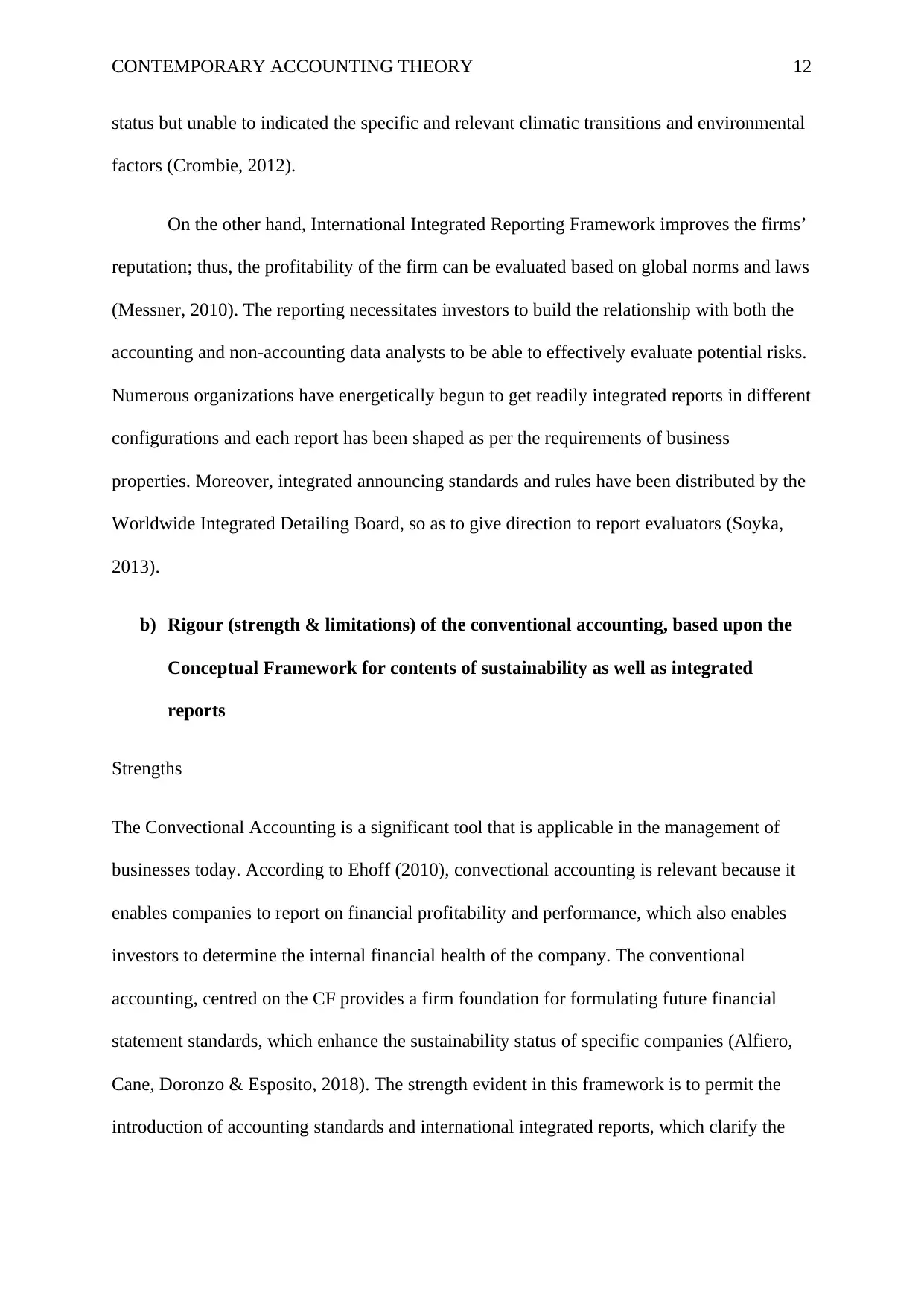
CONTEMPORARY ACCOUNTING THEORY 12
status but unable to indicated the specific and relevant climatic transitions and environmental
factors (Crombie, 2012).
On the other hand, International Integrated Reporting Framework improves the firms’
reputation; thus, the profitability of the firm can be evaluated based on global norms and laws
(Messner, 2010). The reporting necessitates investors to build the relationship with both the
accounting and non-accounting data analysts to be able to effectively evaluate potential risks.
Numerous organizations have energetically begun to get readily integrated reports in different
configurations and each report has been shaped as per the requirements of business
properties. Moreover, integrated announcing standards and rules have been distributed by the
Worldwide Integrated Detailing Board, so as to give direction to report evaluators (Soyka,
2013).
b) Rigour (strength & limitations) of the conventional accounting, based upon the
Conceptual Framework for contents of sustainability as well as integrated
reports
Strengths
The Convectional Accounting is a significant tool that is applicable in the management of
businesses today. According to Ehoff (2010), convectional accounting is relevant because it
enables companies to report on financial profitability and performance, which also enables
investors to determine the internal financial health of the company. The conventional
accounting, centred on the CF provides a firm foundation for formulating future financial
statement standards, which enhance the sustainability status of specific companies (Alfiero,
Cane, Doronzo & Esposito, 2018). The strength evident in this framework is to permit the
introduction of accounting standards and international integrated reports, which clarify the
status but unable to indicated the specific and relevant climatic transitions and environmental
factors (Crombie, 2012).
On the other hand, International Integrated Reporting Framework improves the firms’
reputation; thus, the profitability of the firm can be evaluated based on global norms and laws
(Messner, 2010). The reporting necessitates investors to build the relationship with both the
accounting and non-accounting data analysts to be able to effectively evaluate potential risks.
Numerous organizations have energetically begun to get readily integrated reports in different
configurations and each report has been shaped as per the requirements of business
properties. Moreover, integrated announcing standards and rules have been distributed by the
Worldwide Integrated Detailing Board, so as to give direction to report evaluators (Soyka,
2013).
b) Rigour (strength & limitations) of the conventional accounting, based upon the
Conceptual Framework for contents of sustainability as well as integrated
reports
Strengths
The Convectional Accounting is a significant tool that is applicable in the management of
businesses today. According to Ehoff (2010), convectional accounting is relevant because it
enables companies to report on financial profitability and performance, which also enables
investors to determine the internal financial health of the company. The conventional
accounting, centred on the CF provides a firm foundation for formulating future financial
statement standards, which enhance the sustainability status of specific companies (Alfiero,
Cane, Doronzo & Esposito, 2018). The strength evident in this framework is to permit the
introduction of accounting standards and international integrated reports, which clarify the
⊘ This is a preview!⊘
Do you want full access?
Subscribe today to unlock all pages.

Trusted by 1+ million students worldwide
1 out of 21
Related Documents
Your All-in-One AI-Powered Toolkit for Academic Success.
+13062052269
info@desklib.com
Available 24*7 on WhatsApp / Email
![[object Object]](/_next/static/media/star-bottom.7253800d.svg)
Unlock your academic potential
Copyright © 2020–2025 A2Z Services. All Rights Reserved. Developed and managed by ZUCOL.




